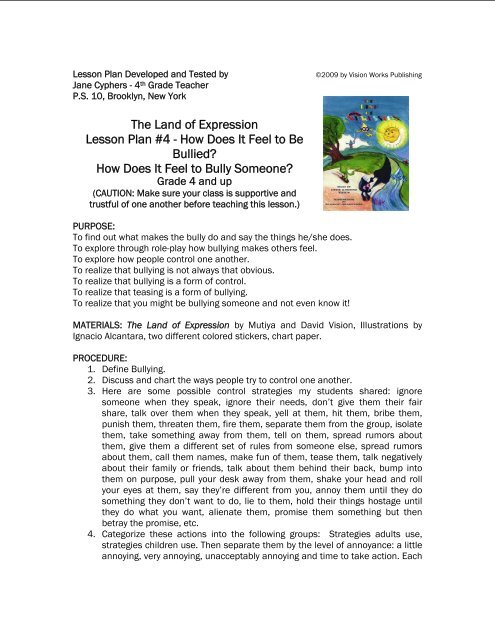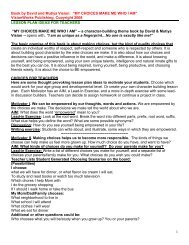Lesson Plan for The Land of Expression - Vision Works Publishing
Lesson Plan for The Land of Expression - Vision Works Publishing
Lesson Plan for The Land of Expression - Vision Works Publishing
Create successful ePaper yourself
Turn your PDF publications into a flip-book with our unique Google optimized e-Paper software.
<strong>Lesson</strong> <strong>Plan</strong> Developed and Tested by<br />
Jane Cyphers - 4 th Grade Teacher<br />
P.S. 10, Brooklyn, New York<br />
©2009 by <strong>Vision</strong> <strong>Works</strong> <strong>Publishing</strong><br />
<strong>The</strong> <strong>Land</strong> <strong>of</strong> <strong>Expression</strong><br />
<strong>Lesson</strong> <strong>Plan</strong> #4 - How Does It Feel to Be<br />
Bullied?<br />
How Does It Feel to Bully Someone?<br />
Grade 4 and up<br />
(CAUTION: Make sure your class is supportive and<br />
trustful <strong>of</strong> one another be<strong>for</strong>e teaching this lesson.)<br />
PURPOSE:<br />
To find out what makes the bully do and say the things he/she does.<br />
To explore through role-play how bullying makes others feel.<br />
To explore how people control one another.<br />
To realize that bullying is not always that obvious.<br />
To realize that bullying is a <strong>for</strong>m <strong>of</strong> control.<br />
To realize that teasing is a <strong>for</strong>m <strong>of</strong> bullying.<br />
To realize that you might be bullying someone and not even know it!<br />
MATERIALS: <strong>The</strong> <strong>Land</strong> <strong>of</strong> <strong>Expression</strong> by Mutiya and David <strong>Vision</strong>, Illustrations by<br />
Ignacio Alcantara, two different colored stickers, chart paper.<br />
PROCEDURE:<br />
1. Define Bullying.<br />
2. Discuss and chart the ways people try to control one another.<br />
3. Here are some possible control strategies my students shared: ignore<br />
someone when they speak, ignore their needs, don’t give them their fair<br />
share, talk over them when they speak, yell at them, hit them, bribe them,<br />
punish them, threaten them, fire them, separate them from the group, isolate<br />
them, take something away from them, tell on them, spread rumors about<br />
them, give them a different set <strong>of</strong> rules from someone else, spread rumors<br />
about them, call them names, make fun <strong>of</strong> them, tease them, talk negatively<br />
about their family or friends, talk about them behind their back, bump into<br />
them on purpose, pull your desk away from them, shake your head and roll<br />
your eyes at them, say they’re different from you, annoy them until they do<br />
something they don’t want to do, lie to them, hold their things hostage until<br />
they do what you want, alienate them, promise them something but then<br />
betray the promise, etc.<br />
4. Categorize these actions into the following groups: Strategies adults use,<br />
strategies children use. <strong>The</strong>n separate them by the level <strong>of</strong> annoyance: a little<br />
annoying, very annoying, unacceptably annoying and time to take action. Each
child should work individually on this. Share with partners. Chart results with<br />
the class.<br />
5. Have students volunteer to be bullied to see how it feels. If you have a group<br />
willing to try it, then set some strict parameters. Be sure to set a time limit and<br />
make sure the adults in charge are aware <strong>of</strong> the “experiment”. <strong>The</strong> bullied will<br />
keep a clipboard to log their experiences. Afterwards the bullied will sit on a<br />
panel and discuss their reactions to the activity as the aggressors listen in.<br />
6. Take the lesson a step further, but this time the bullied will not be aware that<br />
they have been chosen. Secretly put a sticker on the backs <strong>of</strong> each child. All<br />
the stickers will be the same, except <strong>for</strong> the one or ones that the students will<br />
be allowed to bully. <strong>The</strong>se children will have a different colored sticker so the<br />
“bullies” will know who to bully. Again, set the limits. <strong>The</strong> child who is chosen<br />
will not know they are going to be the one bullied or not. <strong>The</strong> bullying<br />
strategies that the students are allowed to use can only come from the “a<br />
little annoying” strategies. <strong>The</strong> bullied may wonder whether or not they are<br />
really being bullied, or whether they’re just being sensitive. Every student will<br />
keep a log <strong>of</strong> all the times they feel they have been bullied. <strong>The</strong> teacher may<br />
join in.<br />
7. After the session, discuss reactions.<br />
FOLLOW-UP:<br />
Discussion might focus on the following:<br />
1. How did it feel to be bullied, even though you knew it was only a roll play?<br />
2. Did you realize anything about yourself or your classmates?<br />
3. How did you react to what the bullies said and did?<br />
4. Was there anything that particularly upset you about what the bullies were saying?<br />
5. Did some people feel bullied, even when no one meant to bully them? Why?<br />
6. Do we do things that hurt each other without realizing it?<br />
7. How did it feel being the aggressor?<br />
8. Did your feelings change after awhile? Why?<br />
9. Did this lesson make you think <strong>of</strong> bullies in a new way?<br />
10. How do people learn to control others?<br />
11. Is it good to control others in some cases?<br />
12. Do you know any bullies?<br />
13. Are you a bully?<br />
Next time, think be<strong>for</strong>e you antagonize, get on someone's nerves, ruffle someone's<br />
feathers, rub someone the wrong way, peeve, hassle, miff, rile, needle, frost, bug, get<br />
someone's goat, get someone's back up, get in someone's hair, drive<br />
mad/crazy/bananas, drive around the bend, drive up the wall, tee <strong>of</strong>f, tick <strong>of</strong>f, burn<br />
up, rankle or bully anyone! Ox<strong>for</strong>d American Dictionary<br />
To order <strong>The</strong> <strong>Land</strong> <strong>of</strong> <strong>Expression</strong>, and <strong>for</strong> more in<strong>for</strong>mation on booking the authors,<br />
or other publications by <strong>Vision</strong> <strong>Works</strong> <strong>Publishing</strong> visit: www.<strong>Vision</strong><strong>Works</strong>Pub.com<br />
(888) 789-6757



